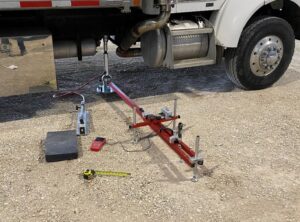Most tests of in-place concrete involve extracting cores for testing in the laboratory. However, Beton also performs nondestructive testing without disturbing the concrete. Nondestructive testing may supplement or guide the extraction of cores, or we may use the tests on their own.
Static plate load testing

Static plate load testing determines the composite modulus of subgrade reaction of engineered fill and reworked existing subgrade for concrete flatwork. Plate tests are performed according to DIN 18134, Determining the Deformation and Strength Characteristics of Soil by the Plate Loading Test. The settlement measuring instrument consists of a measuring frame with probing arm and electronic dial gauge. A heavy vehicle applies the load over the plate.
Each plate load test consists of a loading period, unloading period, and reloading period. The reportable results of each plate load test consist of tabulated normal stress and the corresponding subgrade deformation, calculated values used to determine the soil’s strain modulus, and a plot of normal stress vs. deformation.
MIRA ultrasonic tomography
The MIRA device produces elastic shear-wave impulse time histories in order to reconstruct two-dimensional scans of a concrete plane. It uses dry point contacts, so there’s no need for a coupling agent between the concrete and the transducer. Each MIRA test collects measurements from 45 transducer pairs.
MIRA’s typical operating frequency is 50 kHz in concrete. The shear waves reflect off changes in acoustic impedance. For example, a void or a rebar appears different from the surrounding concrete.
There are two components to a MIRA measurement—a shear surface velocity and a synthetic aperture focusing technique (SAFT) B-scan. The surface velocity measurement establishes the velocity of sound wave travel through the concrete. It indicates material stiffness, which correlates to maturity and strength. During a surface velocity measurement, sound waves travel horizontally through the concrete just below the surface.
The SAFT B-scan produces a two-dimensional, true-to-size tomogram, that is, a picture of the concrete area. MIRA can accurately locate such changes as subsurface defects or rebar. In addition, it has built-in redundancy and self-calibrates, allowing for pavement thickness and rebar depth measurements to within 0.25 in. Finally, it is lightweight, portable, and does not require significant user expertise to collect measurements.
Ultrasonic pulse velocity (UPV)
This test assesses the strength and quality of concrete by measuring the velocity of an ultrasonic pulse passing through a concrete structure. Beton uses this most often to evaluate improper curing in accordance with ASTM C597, Standard Test Method for Pulse Velocity Through Concrete. We review the measurements on site, so we know then and there whether to take additional measurements or extract cores for more information.
Pull-off test
The pull-off test measures the tensile strength of concrete or the bond strength between two different concrete materials. In bridge decks and elevated slabs, precast concrete may receive a cast-in-place topping. Or a bridge deck may get a new topping as part of a rehabilitation project. Either way, you may need to know how well the two materials are bonded.
The test measures the force that de-bonds or fractures a bonded material. In addition, evaluating its failure mode tells us where the problem lies. This is ASTM C1583, Standard Test Method for Tensile Strength of Concrete Surfaces and the Bond Strength or Tensile Strength of Concrete Repair and Overlay Materials by Direct Tension.
Four failure modes are possible with the pull-off test:
- failure of the substrate
- bond failure at the concrete/overlay interface
- failure in the overlay or repair material
- bond failure at the epoxy/overlay interface.
The last situation means that the test itself has failed; that is, we need to do it again. Some specifications call for evaluating the surface preparation of the underlying concrete as well as the strength of the bond between materials using the pull-off test.
Nondestructive testing is useful both to make sure things go right in new construction and in forensic engineering of construction failures.
